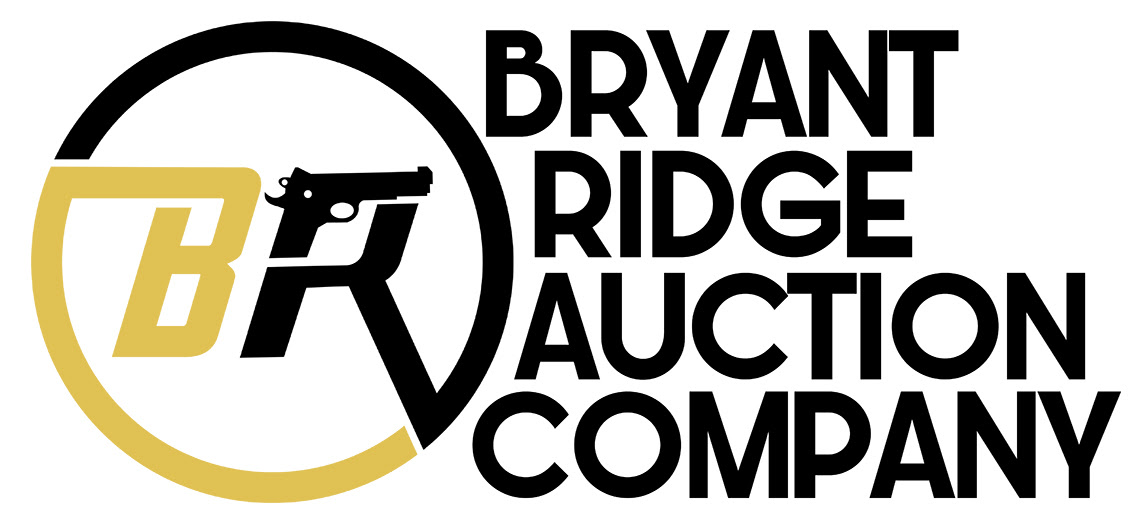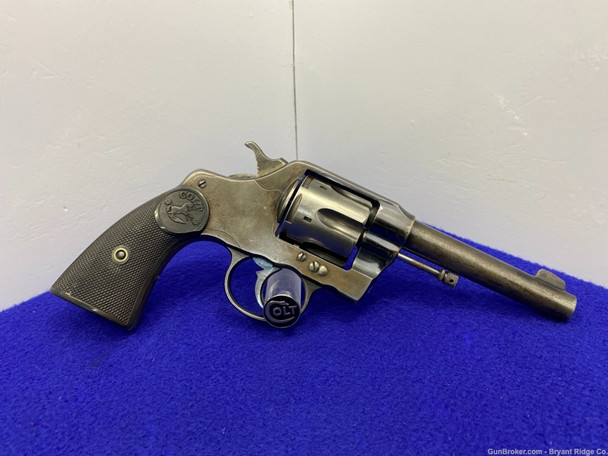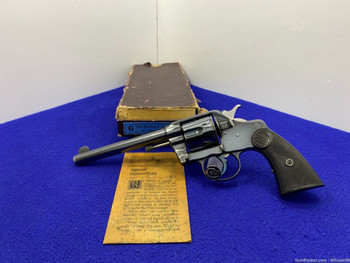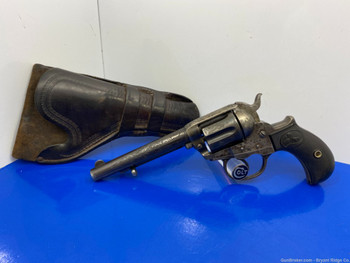Description

Item Description
Bryant Ridge Auction Company is pleased to present this incredibly well preserved double-action revolver today for a penny start auction; this is the Colt New Army!
SPECIFICATIONS:
Manufacturer: Colt
Model: New Army
Serial: 256937
Date of Manufacture: 1906
Caliber: .38 Long Colt
Finish: Blue
Barrel Length: 4.5"
Optics/Sights: Blade Front with Integral Frame Notch Rear
Stock/Grips: Black Synthetic with "Colt" and a rampant horse.
Action: Double/Single
Markings: Standard
Bryant Ridge's Analysis:
In 1889 Colt introduced the world's first double action, swing-out cylinder revolver. This design was so revolutionary that every double action revolver designed since used Colt's swing-out cylinder design.
The US Navy immediately bought the gun as the US Navy Model of 1889, and in 1892 the US Army also bought it in a slightly upgraded model as the US Army Model of 1892. Colt also sold the gun as a commercial sales model, and it was immediately a popular gun with the public. Colt put the new gun through a rapid series of design upgrades with each change getting a new model number. These were the Models 1889, 1892, 1894, 1895, 1896, 1901 and the 1903. Production stopped in 1907.
Serial numbers on the military and commercial models were stamped on the butt in two lines, with military models having US Army or US Navy stamps on the butt and military inspection stamps on the frame. Other parts of the guns were stamped with factory assembly numbers. These numbers were stamped on parts during manufacture to keep fitted parts together until an actual serial number was assigned and stamped on the butt. These assembly numbers are not serial numbers and had no further meaning once the serial number was stamped. It's not unusual to see New Army & Navy revolvers with the serial number and military stamps removed from the bottom of the butt, and people assume the assembly numbers are the serial number, which they are not. It's also common for owners to refuse to accept that the butt stamps were removed without leaving any signs of removal.
Because it was easy to remove stamps from the flat bottom of the frame, Colt began stamping double action revolvers serial number on the frame under the barrel where the cylinder crane seats, on the crane itself, and often inside the side plate. Finish on the military models was blue with smooth walnut grips. Barrel length was 6 inches, and the caliber was the .38 Long Colt. The commercial models were available in blue and bright nickel with black, hard rubber grips with molded in checkering and Colt logo. Barrel lengths offered were 3", 4 1/2", and 6". Calibers were .38 Long Colt, .41 Long Colt, and very late in production in .32-20 and .38 Special.
These Colt's have extremely complex actions that get out of order or break easily. Due to a lack of usable parts and few gunsmiths willing to even attempt repairs, these guns should be treated very gently. The New Army & Navy model is unique to Colt in that the cylinder rotates counter-clockwise, and the frame's side plate is on the right side. In later Colt revolvers the cylinder rotation is clockwise and the side plate is on the left side of the frame. The Model 1889 originally had no locking notches on the outside of the cylinder, using the hand that advanced the cylinder to lock it in place during ignition. This system was a major weakness in the design, since when the action was at rest, the cylinder was free to rotate. This could cause the cylinder to rotate so a fired cartridge was struck when the trigger was pulled instead of a live cartridge.
This was corrected by rebuilding almost all US Navy issue guns to use the same double cylinder locking notches on the outside of the cylinder that were used on the upgraded Model 1892. Commercial Model 1889 revolvers were not recalled for the upgrade, so these guns are recognized by the lack of locking notches on the cylinder.
Return Policy:
We gladly offer a 3 day unfired inspection policy from the time that the firearm is delivered to your FFL. Refunds are available for all qualifying orders.
Model: New Army
Serial: 256937
Date of Manufacture: 1906
Caliber: .38 Long Colt
Finish: Blue
Barrel Length: 4.5"
Optics/Sights: Blade Front with Integral Frame Notch Rear
Stock/Grips: Black Synthetic with "Colt" and a rampant horse.
Action: Double/Single
Markings: Standard
Bryant Ridge's Analysis:
In 1889 Colt introduced the world's first double action, swing-out cylinder revolver. This design was so revolutionary that every double action revolver designed since used Colt's swing-out cylinder design.
The US Navy immediately bought the gun as the US Navy Model of 1889, and in 1892 the US Army also bought it in a slightly upgraded model as the US Army Model of 1892. Colt also sold the gun as a commercial sales model, and it was immediately a popular gun with the public. Colt put the new gun through a rapid series of design upgrades with each change getting a new model number. These were the Models 1889, 1892, 1894, 1895, 1896, 1901 and the 1903. Production stopped in 1907.
Serial numbers on the military and commercial models were stamped on the butt in two lines, with military models having US Army or US Navy stamps on the butt and military inspection stamps on the frame. Other parts of the guns were stamped with factory assembly numbers. These numbers were stamped on parts during manufacture to keep fitted parts together until an actual serial number was assigned and stamped on the butt. These assembly numbers are not serial numbers and had no further meaning once the serial number was stamped. It's not unusual to see New Army & Navy revolvers with the serial number and military stamps removed from the bottom of the butt, and people assume the assembly numbers are the serial number, which they are not. It's also common for owners to refuse to accept that the butt stamps were removed without leaving any signs of removal.
Because it was easy to remove stamps from the flat bottom of the frame, Colt began stamping double action revolvers serial number on the frame under the barrel where the cylinder crane seats, on the crane itself, and often inside the side plate. Finish on the military models was blue with smooth walnut grips. Barrel length was 6 inches, and the caliber was the .38 Long Colt. The commercial models were available in blue and bright nickel with black, hard rubber grips with molded in checkering and Colt logo. Barrel lengths offered were 3", 4 1/2", and 6". Calibers were .38 Long Colt, .41 Long Colt, and very late in production in .32-20 and .38 Special.
These Colt's have extremely complex actions that get out of order or break easily. Due to a lack of usable parts and few gunsmiths willing to even attempt repairs, these guns should be treated very gently. The New Army & Navy model is unique to Colt in that the cylinder rotates counter-clockwise, and the frame's side plate is on the right side. In later Colt revolvers the cylinder rotation is clockwise and the side plate is on the left side of the frame. The Model 1889 originally had no locking notches on the outside of the cylinder, using the hand that advanced the cylinder to lock it in place during ignition. This system was a major weakness in the design, since when the action was at rest, the cylinder was free to rotate. This could cause the cylinder to rotate so a fired cartridge was struck when the trigger was pulled instead of a live cartridge.
This was corrected by rebuilding almost all US Navy issue guns to use the same double cylinder locking notches on the outside of the cylinder that were used on the upgraded Model 1892. Commercial Model 1889 revolvers were not recalled for the upgrade, so these guns are recognized by the lack of locking notches on the cylinder.
Return Policy:
We gladly offer a 3 day unfired inspection policy from the time that the firearm is delivered to your FFL. Refunds are available for all qualifying orders.
Shipping Details
Handgun Standard Shipping $50.00
Long Gun Standard Shipping $70.00
Any orders placed with magazines that are not compliant with your state, county, or city regulations will not ship with your order.
















